Assessment 4: The Significance of Positive Relationships in Education
VerifiedAdded on 2023/06/07
|12
|3580
|240
Homework Assignment
AI Summary
This assignment delves into the critical role of positive relationships in early childhood education, examining various aspects from Bronfenbrenner's theory to practical strategies for educators. It discusses the benefits of fostering positive relationships with children, emphasizing the importance of warm and caring interactions, and the role of educators in collaborating with families. The assignment covers topics such as creating safe environments, utilizing environmental factors to support positive relationships, and understanding the impact of group dynamics on a childcare service. It further explores the link between brain and emotional development, strategies for supporting children in identifying and labeling emotions, and the development of pro-social skills. The assignment also highlights the influence of positive environments on child behavior, the significance of attachment, and the importance of positive communication models. Practical techniques for communication, including the use of questions and consideration of cultural backgrounds, are also discussed. Finally, the assignment examines methods for valuing children's strengths, empowering them to develop limits, and communicating expectations effectively. The work concludes by emphasizing the relationship between understanding child development and building positive and respectful relationships.
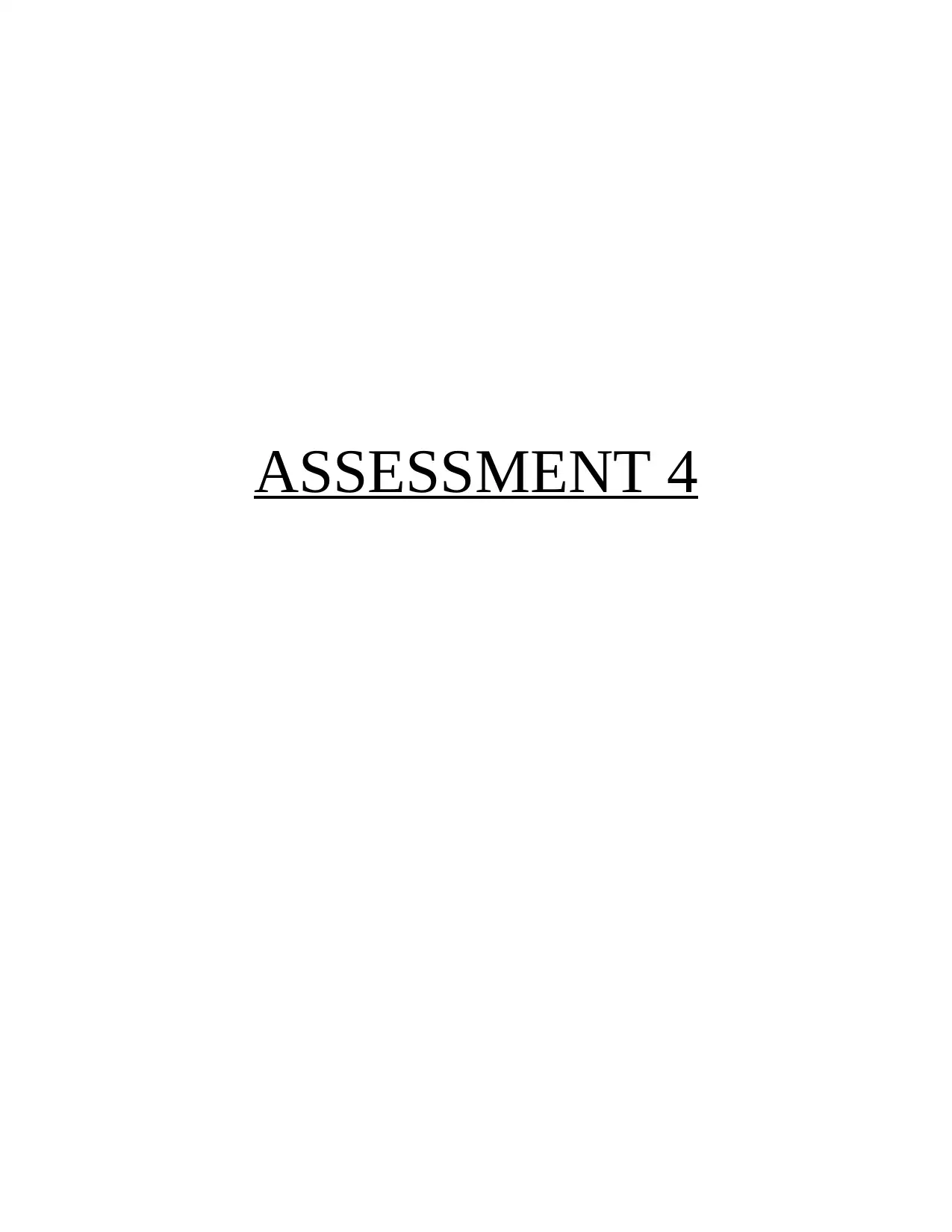
ASSESSMENT 4
Paraphrase This Document
Need a fresh take? Get an instant paraphrase of this document with our AI Paraphraser
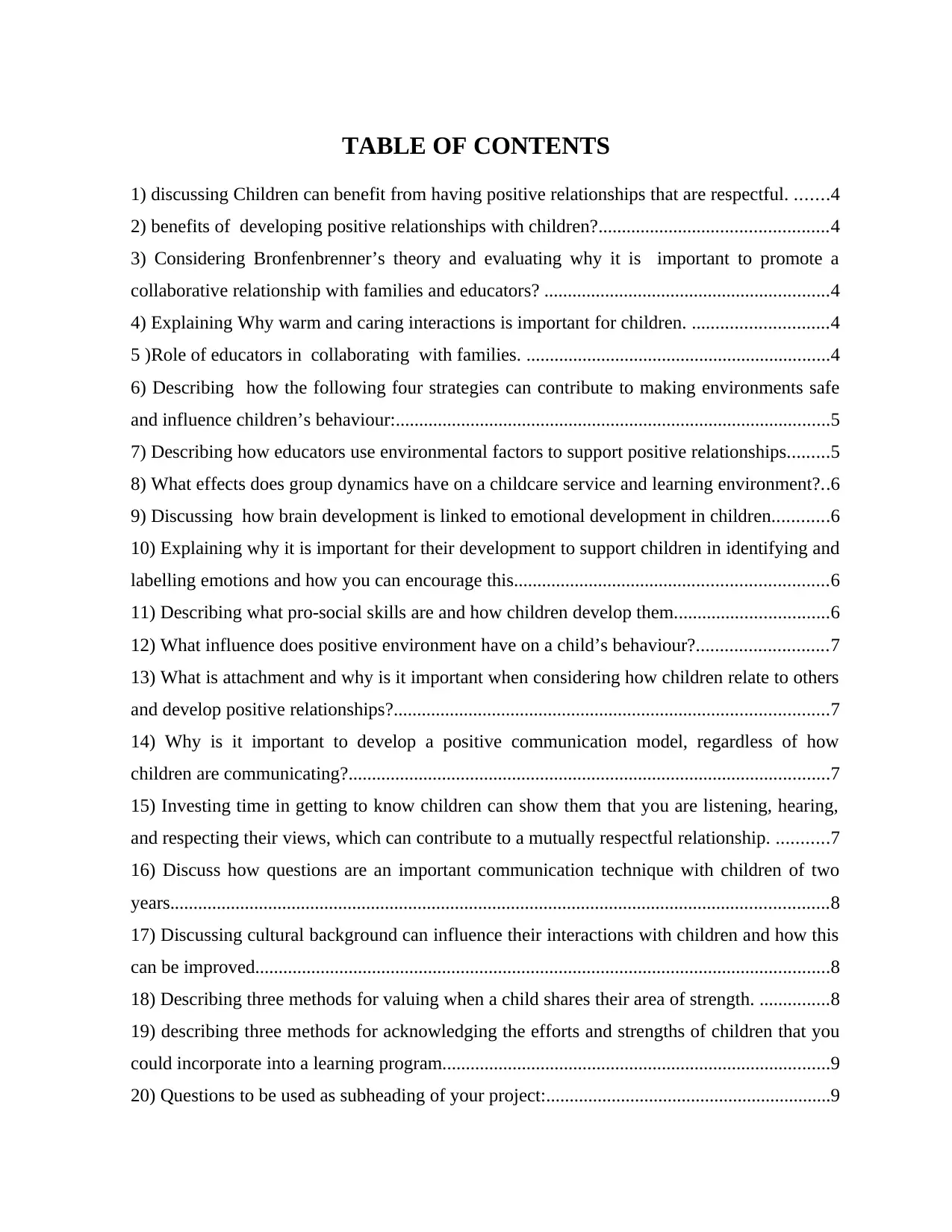
TABLE OF CONTENTS
1) discussing Children can benefit from having positive relationships that are respectful. .......4
2) benefits of developing positive relationships with children?.................................................4
3) Considering Bronfenbrenner’s theory and evaluating why it is important to promote a
collaborative relationship with families and educators? .............................................................4
4) Explaining Why warm and caring interactions is important for children. .............................4
5 )Role of educators in collaborating with families. .................................................................4
6) Describing how the following four strategies can contribute to making environments safe
and influence children’s behaviour:.............................................................................................5
7) Describing how educators use environmental factors to support positive relationships.........5
8) What effects does group dynamics have on a childcare service and learning environment?..6
9) Discussing how brain development is linked to emotional development in children............6
10) Explaining why it is important for their development to support children in identifying and
labelling emotions and how you can encourage this...................................................................6
11) Describing what pro-social skills are and how children develop them.................................6
12) What influence does positive environment have on a child’s behaviour?............................7
13) What is attachment and why is it important when considering how children relate to others
and develop positive relationships?.............................................................................................7
14) Why is it important to develop a positive communication model, regardless of how
children are communicating?.......................................................................................................7
15) Investing time in getting to know children can show them that you are listening, hearing,
and respecting their views, which can contribute to a mutually respectful relationship. ...........7
16) Discuss how questions are an important communication technique with children of two
years.............................................................................................................................................8
17) Discussing cultural background can influence their interactions with children and how this
can be improved...........................................................................................................................8
18) Describing three methods for valuing when a child shares their area of strength. ...............8
19) describing three methods for acknowledging the efforts and strengths of children that you
could incorporate into a learning program...................................................................................9
20) Questions to be used as subheading of your project:.............................................................9
1) discussing Children can benefit from having positive relationships that are respectful. .......4
2) benefits of developing positive relationships with children?.................................................4
3) Considering Bronfenbrenner’s theory and evaluating why it is important to promote a
collaborative relationship with families and educators? .............................................................4
4) Explaining Why warm and caring interactions is important for children. .............................4
5 )Role of educators in collaborating with families. .................................................................4
6) Describing how the following four strategies can contribute to making environments safe
and influence children’s behaviour:.............................................................................................5
7) Describing how educators use environmental factors to support positive relationships.........5
8) What effects does group dynamics have on a childcare service and learning environment?..6
9) Discussing how brain development is linked to emotional development in children............6
10) Explaining why it is important for their development to support children in identifying and
labelling emotions and how you can encourage this...................................................................6
11) Describing what pro-social skills are and how children develop them.................................6
12) What influence does positive environment have on a child’s behaviour?............................7
13) What is attachment and why is it important when considering how children relate to others
and develop positive relationships?.............................................................................................7
14) Why is it important to develop a positive communication model, regardless of how
children are communicating?.......................................................................................................7
15) Investing time in getting to know children can show them that you are listening, hearing,
and respecting their views, which can contribute to a mutually respectful relationship. ...........7
16) Discuss how questions are an important communication technique with children of two
years.............................................................................................................................................8
17) Discussing cultural background can influence their interactions with children and how this
can be improved...........................................................................................................................8
18) Describing three methods for valuing when a child shares their area of strength. ...............8
19) describing three methods for acknowledging the efforts and strengths of children that you
could incorporate into a learning program...................................................................................9
20) Questions to be used as subheading of your project:.............................................................9
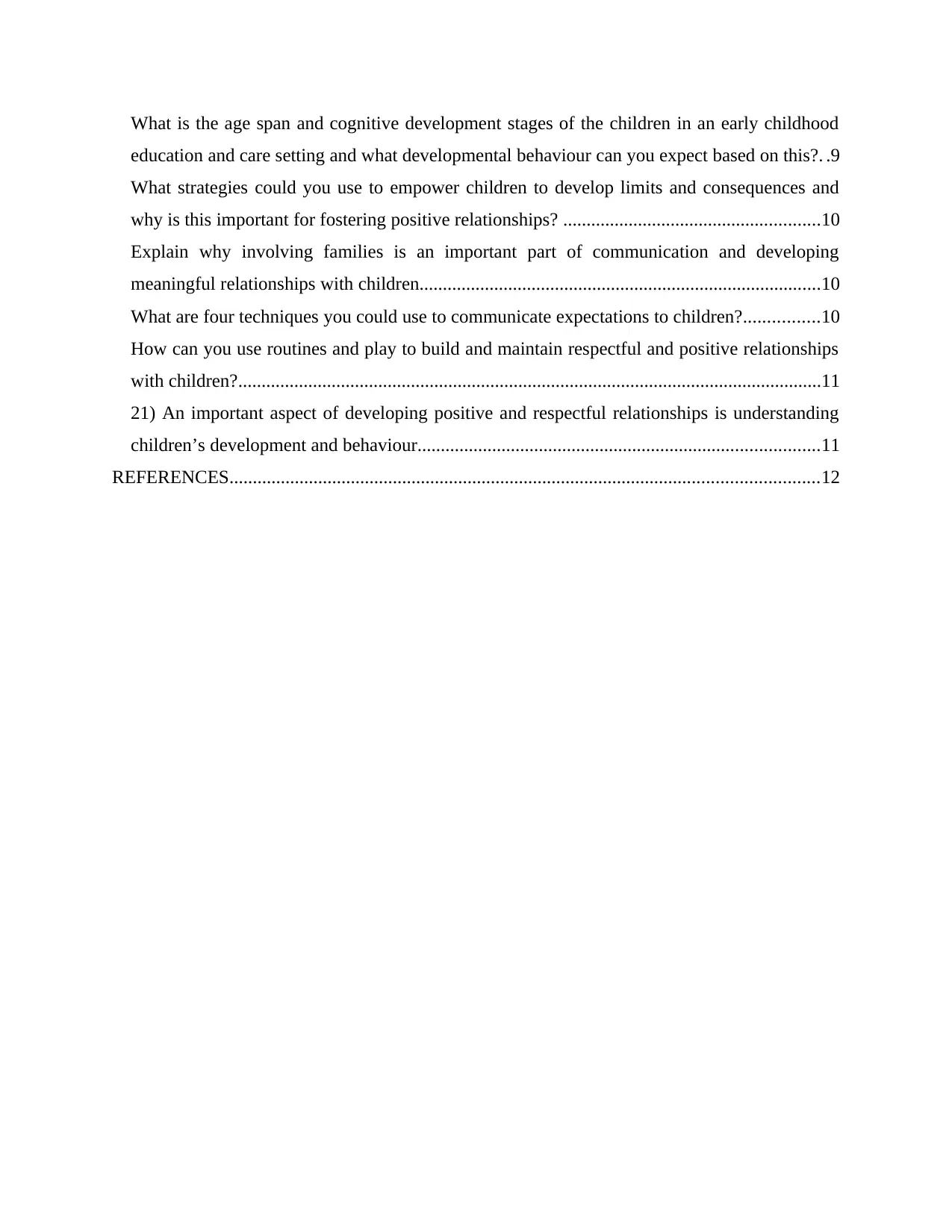
What is the age span and cognitive development stages of the children in an early childhood
education and care setting and what developmental behaviour can you expect based on this?. .9
What strategies could you use to empower children to develop limits and consequences and
why is this important for fostering positive relationships? .......................................................10
Explain why involving families is an important part of communication and developing
meaningful relationships with children......................................................................................10
What are four techniques you could use to communicate expectations to children?................10
How can you use routines and play to build and maintain respectful and positive relationships
with children?.............................................................................................................................11
21) An important aspect of developing positive and respectful relationships is understanding
children’s development and behaviour......................................................................................11
REFERENCES..............................................................................................................................12
education and care setting and what developmental behaviour can you expect based on this?. .9
What strategies could you use to empower children to develop limits and consequences and
why is this important for fostering positive relationships? .......................................................10
Explain why involving families is an important part of communication and developing
meaningful relationships with children......................................................................................10
What are four techniques you could use to communicate expectations to children?................10
How can you use routines and play to build and maintain respectful and positive relationships
with children?.............................................................................................................................11
21) An important aspect of developing positive and respectful relationships is understanding
children’s development and behaviour......................................................................................11
REFERENCES..............................................................................................................................12
⊘ This is a preview!⊘
Do you want full access?
Subscribe today to unlock all pages.

Trusted by 1+ million students worldwide
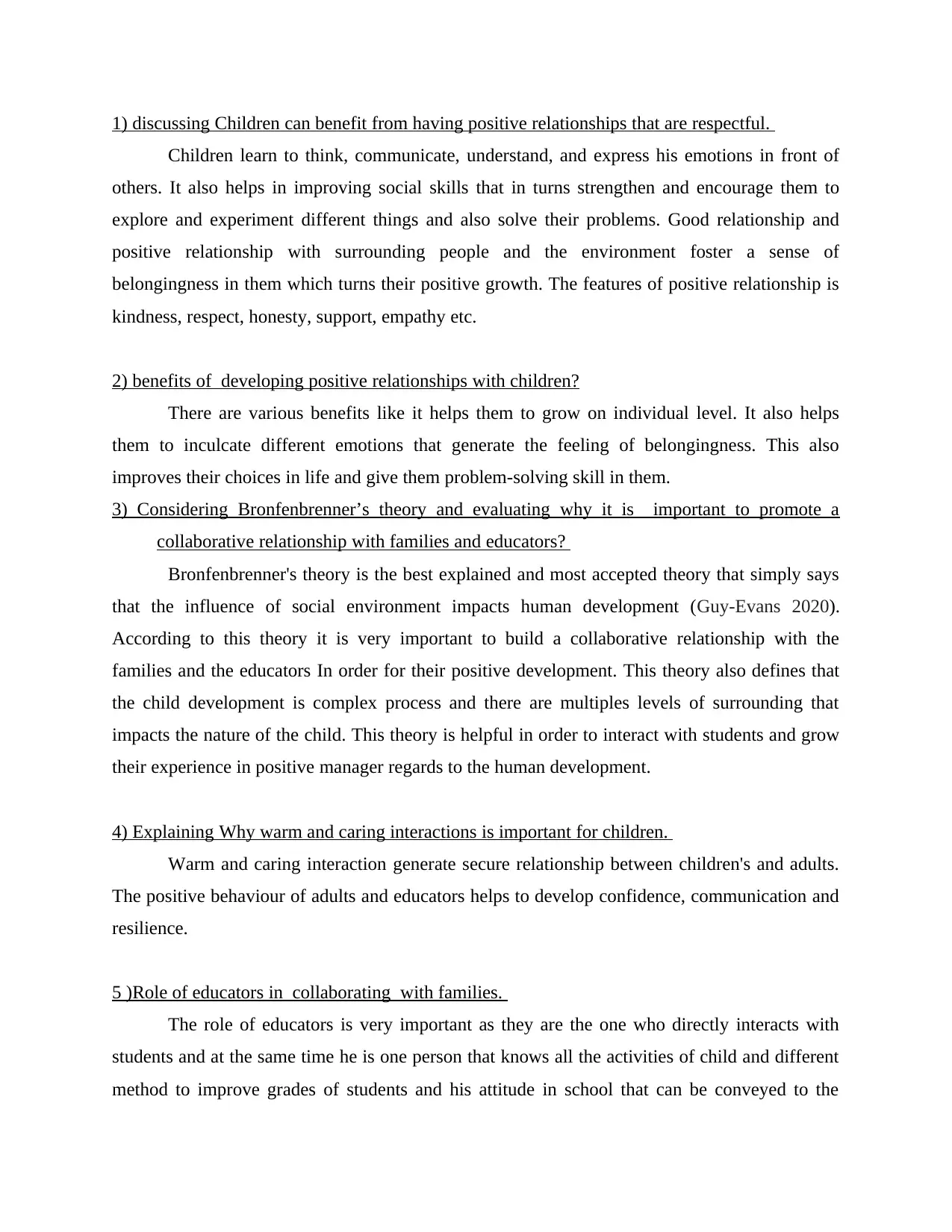
1) discussing Children can benefit from having positive relationships that are respectful.
Children learn to think, communicate, understand, and express his emotions in front of
others. It also helps in improving social skills that in turns strengthen and encourage them to
explore and experiment different things and also solve their problems. Good relationship and
positive relationship with surrounding people and the environment foster a sense of
belongingness in them which turns their positive growth. The features of positive relationship is
kindness, respect, honesty, support, empathy etc.
2) benefits of developing positive relationships with children?
There are various benefits like it helps them to grow on individual level. It also helps
them to inculcate different emotions that generate the feeling of belongingness. This also
improves their choices in life and give them problem-solving skill in them.
3) Considering Bronfenbrenner’s theory and evaluating why it is important to promote a
collaborative relationship with families and educators?
Bronfenbrenner's theory is the best explained and most accepted theory that simply says
that the influence of social environment impacts human development (Guy-Evans 2020).
According to this theory it is very important to build a collaborative relationship with the
families and the educators In order for their positive development. This theory also defines that
the child development is complex process and there are multiples levels of surrounding that
impacts the nature of the child. This theory is helpful in order to interact with students and grow
their experience in positive manager regards to the human development.
4) Explaining Why warm and caring interactions is important for children.
Warm and caring interaction generate secure relationship between children's and adults.
The positive behaviour of adults and educators helps to develop confidence, communication and
resilience.
5 )Role of educators in collaborating with families.
The role of educators is very important as they are the one who directly interacts with
students and at the same time he is one person that knows all the activities of child and different
method to improve grades of students and his attitude in school that can be conveyed to the
Children learn to think, communicate, understand, and express his emotions in front of
others. It also helps in improving social skills that in turns strengthen and encourage them to
explore and experiment different things and also solve their problems. Good relationship and
positive relationship with surrounding people and the environment foster a sense of
belongingness in them which turns their positive growth. The features of positive relationship is
kindness, respect, honesty, support, empathy etc.
2) benefits of developing positive relationships with children?
There are various benefits like it helps them to grow on individual level. It also helps
them to inculcate different emotions that generate the feeling of belongingness. This also
improves their choices in life and give them problem-solving skill in them.
3) Considering Bronfenbrenner’s theory and evaluating why it is important to promote a
collaborative relationship with families and educators?
Bronfenbrenner's theory is the best explained and most accepted theory that simply says
that the influence of social environment impacts human development (Guy-Evans 2020).
According to this theory it is very important to build a collaborative relationship with the
families and the educators In order for their positive development. This theory also defines that
the child development is complex process and there are multiples levels of surrounding that
impacts the nature of the child. This theory is helpful in order to interact with students and grow
their experience in positive manager regards to the human development.
4) Explaining Why warm and caring interactions is important for children.
Warm and caring interaction generate secure relationship between children's and adults.
The positive behaviour of adults and educators helps to develop confidence, communication and
resilience.
5 )Role of educators in collaborating with families.
The role of educators is very important as they are the one who directly interacts with
students and at the same time he is one person that knows all the activities of child and different
method to improve grades of students and his attitude in school that can be conveyed to the
Paraphrase This Document
Need a fresh take? Get an instant paraphrase of this document with our AI Paraphraser

students. They are the ones that demonstrate their social skills and views their behavioural
problems and contacts with the parents in order to get out of the problem they are facing.
6) Describing how the following four strategies can contribute to making environments safe and
influence children’s behaviour:
Designing rooms based on child preferences-
This is the most basic strategy that contributes to make safe environment for children. It
acts as a love and warm attitude towards the children's. This gives them comfort that is basic
need for any child career as comfort gives them confidence to perform all the activities in their
room itself.
Making the space inviting and safe-
The safe and secure space relaxes them. The more they visit any safe space, the more
they enjoy. Enjoying and making them happy is the ultimate aim of any parents and educators
and this can be the best way to influence their behaviour and give them happiness.
Educator Interactions-
Educators interactions is also another way that influences the behaviour of the children's.
Role of educators is not limited to making them learn study material. Instead, the role of teachers
has become wider. All the academic skills like communication, motivation, confidence are
taught to them by the teachers.
Routines and time-
Routine give them discipline to work daily. Discipline is one such a habit that every child
must have in him in order to perform good task in whatever works comes in his hand. Children's
today are not active in routine that impact their ability to perform In task and earn less marks
than others.
7) Describing how educators use environmental factors to support positive relationships.
Educators are the best advisors that create positive relationship with the students in order
to build their academic skills. Without good educators it is very difficult to raise students in
changing environment today.
A blend of familiar and unfamiliar environment-
problems and contacts with the parents in order to get out of the problem they are facing.
6) Describing how the following four strategies can contribute to making environments safe and
influence children’s behaviour:
Designing rooms based on child preferences-
This is the most basic strategy that contributes to make safe environment for children. It
acts as a love and warm attitude towards the children's. This gives them comfort that is basic
need for any child career as comfort gives them confidence to perform all the activities in their
room itself.
Making the space inviting and safe-
The safe and secure space relaxes them. The more they visit any safe space, the more
they enjoy. Enjoying and making them happy is the ultimate aim of any parents and educators
and this can be the best way to influence their behaviour and give them happiness.
Educator Interactions-
Educators interactions is also another way that influences the behaviour of the children's.
Role of educators is not limited to making them learn study material. Instead, the role of teachers
has become wider. All the academic skills like communication, motivation, confidence are
taught to them by the teachers.
Routines and time-
Routine give them discipline to work daily. Discipline is one such a habit that every child
must have in him in order to perform good task in whatever works comes in his hand. Children's
today are not active in routine that impact their ability to perform In task and earn less marks
than others.
7) Describing how educators use environmental factors to support positive relationships.
Educators are the best advisors that create positive relationship with the students in order
to build their academic skills. Without good educators it is very difficult to raise students in
changing environment today.
A blend of familiar and unfamiliar environment-
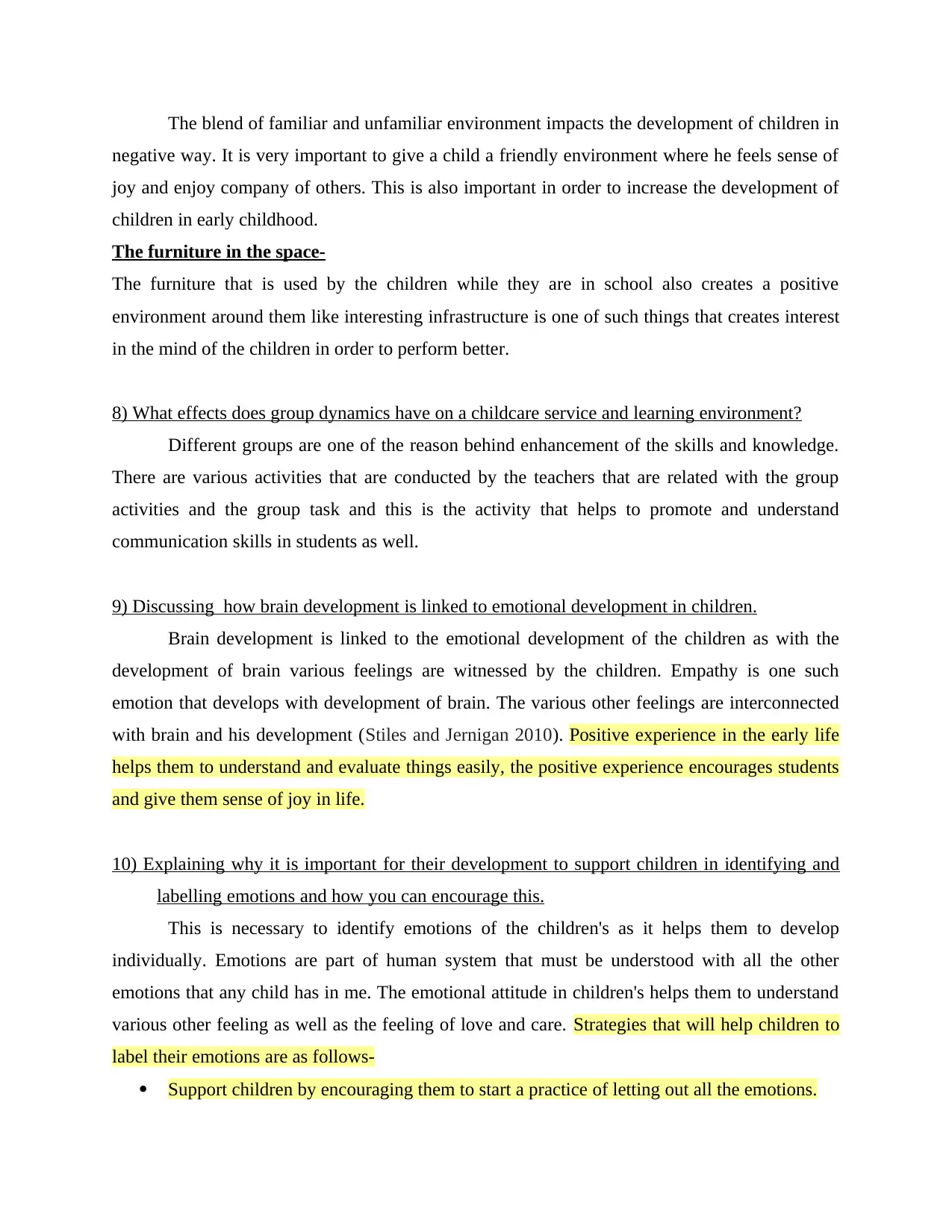
The blend of familiar and unfamiliar environment impacts the development of children in
negative way. It is very important to give a child a friendly environment where he feels sense of
joy and enjoy company of others. This is also important in order to increase the development of
children in early childhood.
The furniture in the space-
The furniture that is used by the children while they are in school also creates a positive
environment around them like interesting infrastructure is one of such things that creates interest
in the mind of the children in order to perform better.
8) What effects does group dynamics have on a childcare service and learning environment?
Different groups are one of the reason behind enhancement of the skills and knowledge.
There are various activities that are conducted by the teachers that are related with the group
activities and the group task and this is the activity that helps to promote and understand
communication skills in students as well.
9) Discussing how brain development is linked to emotional development in children.
Brain development is linked to the emotional development of the children as with the
development of brain various feelings are witnessed by the children. Empathy is one such
emotion that develops with development of brain. The various other feelings are interconnected
with brain and his development (Stiles and Jernigan 2010). Positive experience in the early life
helps them to understand and evaluate things easily, the positive experience encourages students
and give them sense of joy in life.
10) Explaining why it is important for their development to support children in identifying and
labelling emotions and how you can encourage this.
This is necessary to identify emotions of the children's as it helps them to develop
individually. Emotions are part of human system that must be understood with all the other
emotions that any child has in me. The emotional attitude in children's helps them to understand
various other feeling as well as the feeling of love and care. Strategies that will help children to
label their emotions are as follows-
Support children by encouraging them to start a practice of letting out all the emotions.
negative way. It is very important to give a child a friendly environment where he feels sense of
joy and enjoy company of others. This is also important in order to increase the development of
children in early childhood.
The furniture in the space-
The furniture that is used by the children while they are in school also creates a positive
environment around them like interesting infrastructure is one of such things that creates interest
in the mind of the children in order to perform better.
8) What effects does group dynamics have on a childcare service and learning environment?
Different groups are one of the reason behind enhancement of the skills and knowledge.
There are various activities that are conducted by the teachers that are related with the group
activities and the group task and this is the activity that helps to promote and understand
communication skills in students as well.
9) Discussing how brain development is linked to emotional development in children.
Brain development is linked to the emotional development of the children as with the
development of brain various feelings are witnessed by the children. Empathy is one such
emotion that develops with development of brain. The various other feelings are interconnected
with brain and his development (Stiles and Jernigan 2010). Positive experience in the early life
helps them to understand and evaluate things easily, the positive experience encourages students
and give them sense of joy in life.
10) Explaining why it is important for their development to support children in identifying and
labelling emotions and how you can encourage this.
This is necessary to identify emotions of the children's as it helps them to develop
individually. Emotions are part of human system that must be understood with all the other
emotions that any child has in me. The emotional attitude in children's helps them to understand
various other feeling as well as the feeling of love and care. Strategies that will help children to
label their emotions are as follows-
Support children by encouraging them to start a practice of letting out all the emotions.
⊘ This is a preview!⊘
Do you want full access?
Subscribe today to unlock all pages.

Trusted by 1+ million students worldwide
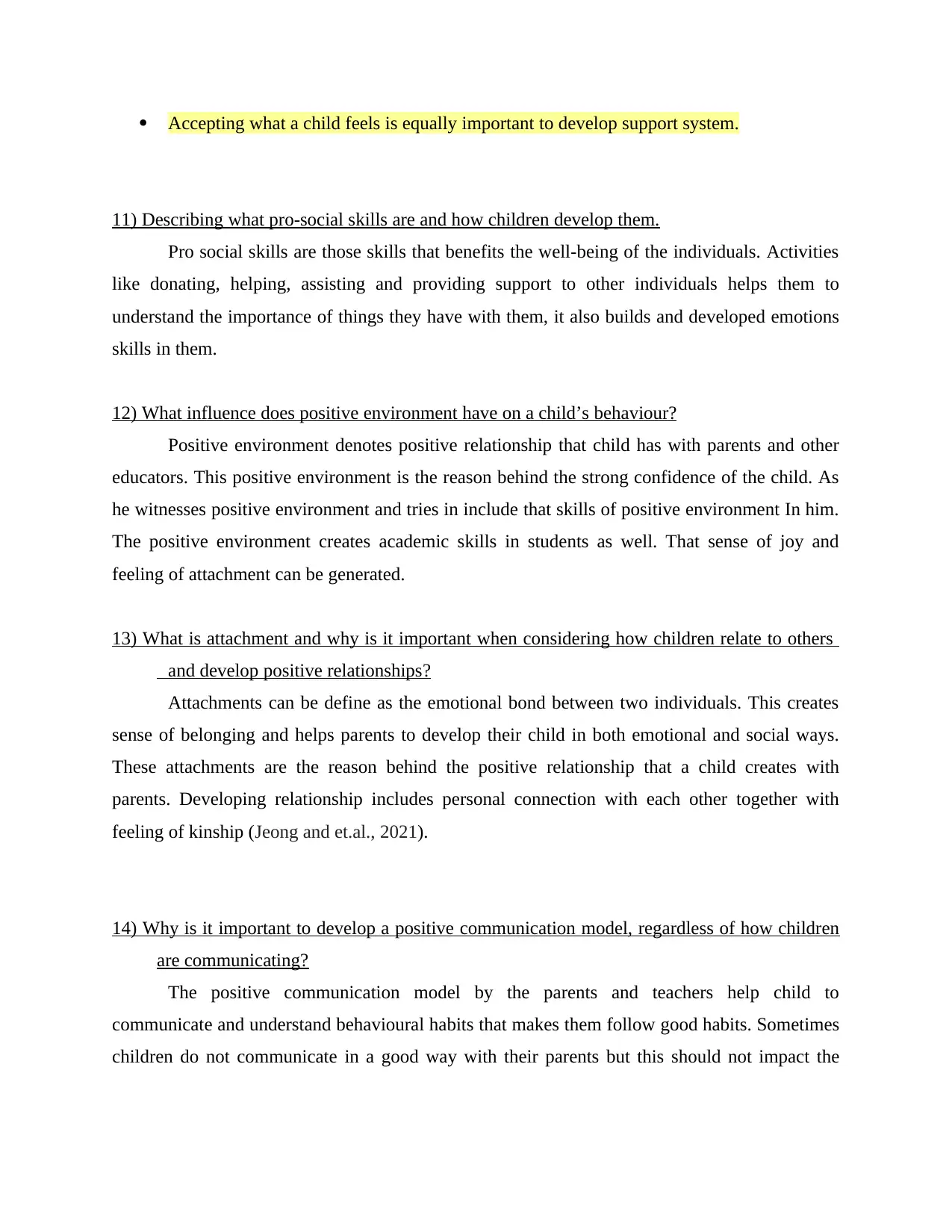
Accepting what a child feels is equally important to develop support system.
11) Describing what pro-social skills are and how children develop them.
Pro social skills are those skills that benefits the well-being of the individuals. Activities
like donating, helping, assisting and providing support to other individuals helps them to
understand the importance of things they have with them, it also builds and developed emotions
skills in them.
12) What influence does positive environment have on a child’s behaviour?
Positive environment denotes positive relationship that child has with parents and other
educators. This positive environment is the reason behind the strong confidence of the child. As
he witnesses positive environment and tries in include that skills of positive environment In him.
The positive environment creates academic skills in students as well. That sense of joy and
feeling of attachment can be generated.
13) What is attachment and why is it important when considering how children relate to others
and develop positive relationships?
Attachments can be define as the emotional bond between two individuals. This creates
sense of belonging and helps parents to develop their child in both emotional and social ways.
These attachments are the reason behind the positive relationship that a child creates with
parents. Developing relationship includes personal connection with each other together with
feeling of kinship (Jeong and et.al., 2021).
14) Why is it important to develop a positive communication model, regardless of how children
are communicating?
The positive communication model by the parents and teachers help child to
communicate and understand behavioural habits that makes them follow good habits. Sometimes
children do not communicate in a good way with their parents but this should not impact the
11) Describing what pro-social skills are and how children develop them.
Pro social skills are those skills that benefits the well-being of the individuals. Activities
like donating, helping, assisting and providing support to other individuals helps them to
understand the importance of things they have with them, it also builds and developed emotions
skills in them.
12) What influence does positive environment have on a child’s behaviour?
Positive environment denotes positive relationship that child has with parents and other
educators. This positive environment is the reason behind the strong confidence of the child. As
he witnesses positive environment and tries in include that skills of positive environment In him.
The positive environment creates academic skills in students as well. That sense of joy and
feeling of attachment can be generated.
13) What is attachment and why is it important when considering how children relate to others
and develop positive relationships?
Attachments can be define as the emotional bond between two individuals. This creates
sense of belonging and helps parents to develop their child in both emotional and social ways.
These attachments are the reason behind the positive relationship that a child creates with
parents. Developing relationship includes personal connection with each other together with
feeling of kinship (Jeong and et.al., 2021).
14) Why is it important to develop a positive communication model, regardless of how children
are communicating?
The positive communication model by the parents and teachers help child to
communicate and understand behavioural habits that makes them follow good habits. Sometimes
children do not communicate in a good way with their parents but this should not impact the
Paraphrase This Document
Need a fresh take? Get an instant paraphrase of this document with our AI Paraphraser
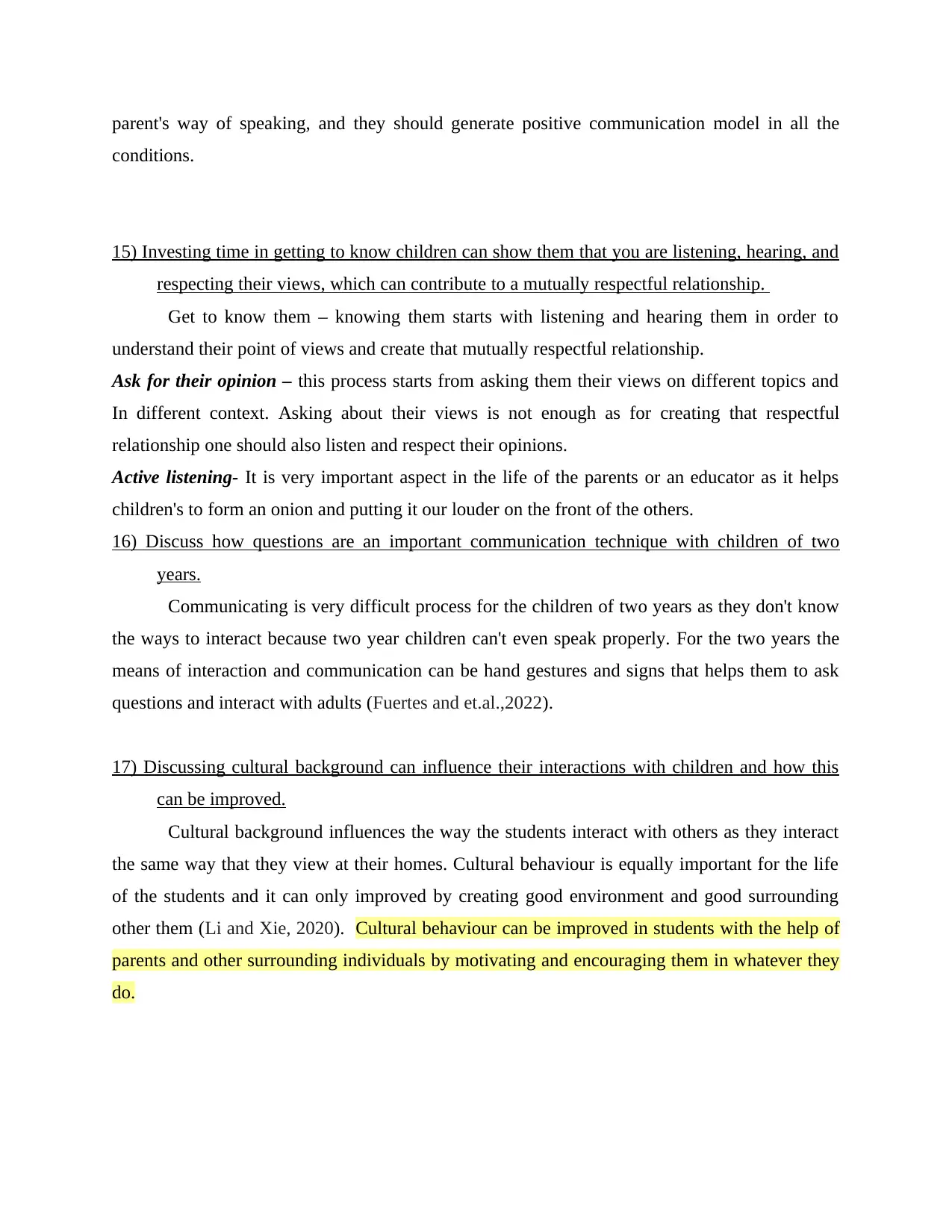
parent's way of speaking, and they should generate positive communication model in all the
conditions.
15) Investing time in getting to know children can show them that you are listening, hearing, and
respecting their views, which can contribute to a mutually respectful relationship.
Get to know them – knowing them starts with listening and hearing them in order to
understand their point of views and create that mutually respectful relationship.
Ask for their opinion – this process starts from asking them their views on different topics and
In different context. Asking about their views is not enough as for creating that respectful
relationship one should also listen and respect their opinions.
Active listening- It is very important aspect in the life of the parents or an educator as it helps
children's to form an onion and putting it our louder on the front of the others.
16) Discuss how questions are an important communication technique with children of two
years.
Communicating is very difficult process for the children of two years as they don't know
the ways to interact because two year children can't even speak properly. For the two years the
means of interaction and communication can be hand gestures and signs that helps them to ask
questions and interact with adults (Fuertes and et.al.,2022).
17) Discussing cultural background can influence their interactions with children and how this
can be improved.
Cultural background influences the way the students interact with others as they interact
the same way that they view at their homes. Cultural behaviour is equally important for the life
of the students and it can only improved by creating good environment and good surrounding
other them (Li and Xie, 2020). Cultural behaviour can be improved in students with the help of
parents and other surrounding individuals by motivating and encouraging them in whatever they
do.
conditions.
15) Investing time in getting to know children can show them that you are listening, hearing, and
respecting their views, which can contribute to a mutually respectful relationship.
Get to know them – knowing them starts with listening and hearing them in order to
understand their point of views and create that mutually respectful relationship.
Ask for their opinion – this process starts from asking them their views on different topics and
In different context. Asking about their views is not enough as for creating that respectful
relationship one should also listen and respect their opinions.
Active listening- It is very important aspect in the life of the parents or an educator as it helps
children's to form an onion and putting it our louder on the front of the others.
16) Discuss how questions are an important communication technique with children of two
years.
Communicating is very difficult process for the children of two years as they don't know
the ways to interact because two year children can't even speak properly. For the two years the
means of interaction and communication can be hand gestures and signs that helps them to ask
questions and interact with adults (Fuertes and et.al.,2022).
17) Discussing cultural background can influence their interactions with children and how this
can be improved.
Cultural background influences the way the students interact with others as they interact
the same way that they view at their homes. Cultural behaviour is equally important for the life
of the students and it can only improved by creating good environment and good surrounding
other them (Li and Xie, 2020). Cultural behaviour can be improved in students with the help of
parents and other surrounding individuals by motivating and encouraging them in whatever they
do.
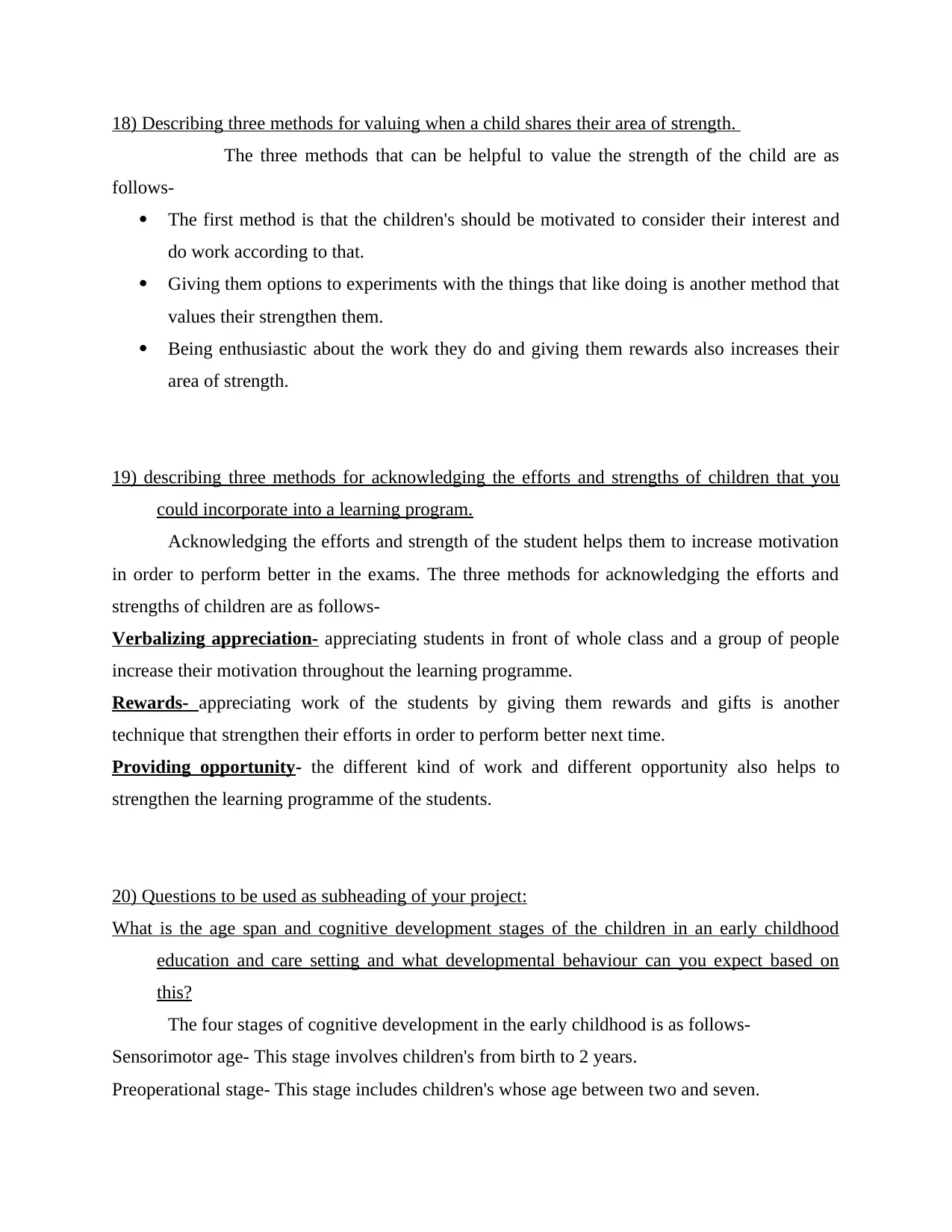
18) Describing three methods for valuing when a child shares their area of strength.
The three methods that can be helpful to value the strength of the child are as
follows-
The first method is that the children's should be motivated to consider their interest and
do work according to that.
Giving them options to experiments with the things that like doing is another method that
values their strengthen them.
Being enthusiastic about the work they do and giving them rewards also increases their
area of strength.
19) describing three methods for acknowledging the efforts and strengths of children that you
could incorporate into a learning program.
Acknowledging the efforts and strength of the student helps them to increase motivation
in order to perform better in the exams. The three methods for acknowledging the efforts and
strengths of children are as follows-
Verbalizing appreciation- appreciating students in front of whole class and a group of people
increase their motivation throughout the learning programme.
Rewards- appreciating work of the students by giving them rewards and gifts is another
technique that strengthen their efforts in order to perform better next time.
Providing opportunity- the different kind of work and different opportunity also helps to
strengthen the learning programme of the students.
20) Questions to be used as subheading of your project:
What is the age span and cognitive development stages of the children in an early childhood
education and care setting and what developmental behaviour can you expect based on
this?
The four stages of cognitive development in the early childhood is as follows-
Sensorimotor age- This stage involves children's from birth to 2 years.
Preoperational stage- This stage includes children's whose age between two and seven.
The three methods that can be helpful to value the strength of the child are as
follows-
The first method is that the children's should be motivated to consider their interest and
do work according to that.
Giving them options to experiments with the things that like doing is another method that
values their strengthen them.
Being enthusiastic about the work they do and giving them rewards also increases their
area of strength.
19) describing three methods for acknowledging the efforts and strengths of children that you
could incorporate into a learning program.
Acknowledging the efforts and strength of the student helps them to increase motivation
in order to perform better in the exams. The three methods for acknowledging the efforts and
strengths of children are as follows-
Verbalizing appreciation- appreciating students in front of whole class and a group of people
increase their motivation throughout the learning programme.
Rewards- appreciating work of the students by giving them rewards and gifts is another
technique that strengthen their efforts in order to perform better next time.
Providing opportunity- the different kind of work and different opportunity also helps to
strengthen the learning programme of the students.
20) Questions to be used as subheading of your project:
What is the age span and cognitive development stages of the children in an early childhood
education and care setting and what developmental behaviour can you expect based on
this?
The four stages of cognitive development in the early childhood is as follows-
Sensorimotor age- This stage involves children's from birth to 2 years.
Preoperational stage- This stage includes children's whose age between two and seven.
⊘ This is a preview!⊘
Do you want full access?
Subscribe today to unlock all pages.

Trusted by 1+ million students worldwide
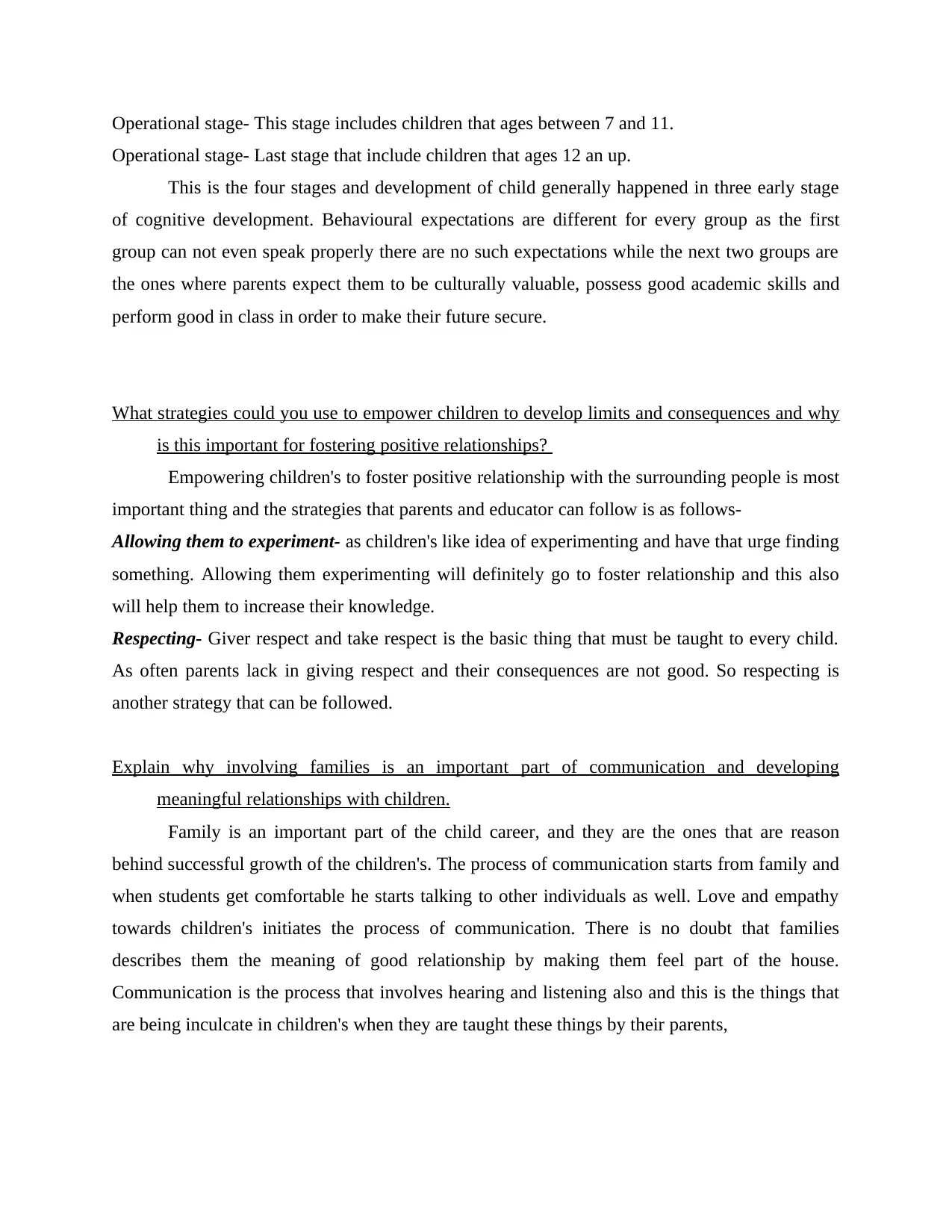
Operational stage- This stage includes children that ages between 7 and 11.
Operational stage- Last stage that include children that ages 12 an up.
This is the four stages and development of child generally happened in three early stage
of cognitive development. Behavioural expectations are different for every group as the first
group can not even speak properly there are no such expectations while the next two groups are
the ones where parents expect them to be culturally valuable, possess good academic skills and
perform good in class in order to make their future secure.
What strategies could you use to empower children to develop limits and consequences and why
is this important for fostering positive relationships?
Empowering children's to foster positive relationship with the surrounding people is most
important thing and the strategies that parents and educator can follow is as follows-
Allowing them to experiment- as children's like idea of experimenting and have that urge finding
something. Allowing them experimenting will definitely go to foster relationship and this also
will help them to increase their knowledge.
Respecting- Giver respect and take respect is the basic thing that must be taught to every child.
As often parents lack in giving respect and their consequences are not good. So respecting is
another strategy that can be followed.
Explain why involving families is an important part of communication and developing
meaningful relationships with children.
Family is an important part of the child career, and they are the ones that are reason
behind successful growth of the children's. The process of communication starts from family and
when students get comfortable he starts talking to other individuals as well. Love and empathy
towards children's initiates the process of communication. There is no doubt that families
describes them the meaning of good relationship by making them feel part of the house.
Communication is the process that involves hearing and listening also and this is the things that
are being inculcate in children's when they are taught these things by their parents,
Operational stage- Last stage that include children that ages 12 an up.
This is the four stages and development of child generally happened in three early stage
of cognitive development. Behavioural expectations are different for every group as the first
group can not even speak properly there are no such expectations while the next two groups are
the ones where parents expect them to be culturally valuable, possess good academic skills and
perform good in class in order to make their future secure.
What strategies could you use to empower children to develop limits and consequences and why
is this important for fostering positive relationships?
Empowering children's to foster positive relationship with the surrounding people is most
important thing and the strategies that parents and educator can follow is as follows-
Allowing them to experiment- as children's like idea of experimenting and have that urge finding
something. Allowing them experimenting will definitely go to foster relationship and this also
will help them to increase their knowledge.
Respecting- Giver respect and take respect is the basic thing that must be taught to every child.
As often parents lack in giving respect and their consequences are not good. So respecting is
another strategy that can be followed.
Explain why involving families is an important part of communication and developing
meaningful relationships with children.
Family is an important part of the child career, and they are the ones that are reason
behind successful growth of the children's. The process of communication starts from family and
when students get comfortable he starts talking to other individuals as well. Love and empathy
towards children's initiates the process of communication. There is no doubt that families
describes them the meaning of good relationship by making them feel part of the house.
Communication is the process that involves hearing and listening also and this is the things that
are being inculcate in children's when they are taught these things by their parents,
Paraphrase This Document
Need a fresh take? Get an instant paraphrase of this document with our AI Paraphraser

What are four techniques you could use to communicate expectations to children?
The four techniques that can be used to communicate with the children's are as follows-
Speaking clearly- using language that child is comfortable with it is the most appropriate
technique to communicate with children's. Expressing your feelings with the hand gestures also
comes in part of speaking clearly with child.
Listening- As mentioned earlies that communication involves listening process as well. That
simply means parents and educators must also believe in active listening to answer their
questions as soon as possible. This enables smooth process between two and create the drive in
children's to ask more such questions.
Explaining feelings- This helps them to develop level of emotional intelligence. While growing,
it also becomes important that the children's learn these skills that will help them to speak out
without judgements. Empathy is one such skill that the child must learn.
Behaviour focusing- focusing on the behaviour of child is also one of the major technique that
helps to build the process of communication. Communication can be smoother by following this
techniques above and these techniques will also help them to foster good relationship with each
other.
How can you use routines and play to build and maintain respectful and positive relationships
with children?
The routine to go to school and perform certain activity that helps individual to grow his
skill for the lifetime is very important part of children's life in the early stage. The positive
relationship are created in such a way that the parents also perform some activities together with
the child in order to build his interest in different activities. This helps a child to discover to new
academic skills will in turn make them perform better in classes (Goldstein and McGinnis, E.,
2015).
Students learn from their parents and discipline is one such thing that must be inculcate in
children's to make them frank with the things that are around. Regular activities also increases
their skill of time management. As time management is important skill that every one should
have in him, this skill can easily be learned to the child by the process of routines and is also
helpful in maintaining respectful relationship.
The four techniques that can be used to communicate with the children's are as follows-
Speaking clearly- using language that child is comfortable with it is the most appropriate
technique to communicate with children's. Expressing your feelings with the hand gestures also
comes in part of speaking clearly with child.
Listening- As mentioned earlies that communication involves listening process as well. That
simply means parents and educators must also believe in active listening to answer their
questions as soon as possible. This enables smooth process between two and create the drive in
children's to ask more such questions.
Explaining feelings- This helps them to develop level of emotional intelligence. While growing,
it also becomes important that the children's learn these skills that will help them to speak out
without judgements. Empathy is one such skill that the child must learn.
Behaviour focusing- focusing on the behaviour of child is also one of the major technique that
helps to build the process of communication. Communication can be smoother by following this
techniques above and these techniques will also help them to foster good relationship with each
other.
How can you use routines and play to build and maintain respectful and positive relationships
with children?
The routine to go to school and perform certain activity that helps individual to grow his
skill for the lifetime is very important part of children's life in the early stage. The positive
relationship are created in such a way that the parents also perform some activities together with
the child in order to build his interest in different activities. This helps a child to discover to new
academic skills will in turn make them perform better in classes (Goldstein and McGinnis, E.,
2015).
Students learn from their parents and discipline is one such thing that must be inculcate in
children's to make them frank with the things that are around. Regular activities also increases
their skill of time management. As time management is important skill that every one should
have in him, this skill can easily be learned to the child by the process of routines and is also
helpful in maintaining respectful relationship.

21) An important aspect of developing positive and respectful relationships is understanding
children’s development and behaviour.
Developing positive relationship is very important to understand the behaviour of
children as the more students leave with their parents and educators, the more they get to know
the different aspects of their life.
REFERENCES
Books and Journals
Jeong, J., and et.al., 2021. Parenting interventions to promote early child development in the first
three years of life: A global systematic review and meta-analysis. PLoS medicine .18(5).
p.e1003602.
Fuertes, M., and et.al.,2022. Interacting and communicating with children: an exploratory study
about educators’ behavior during a collaborative activity European Early Childhood
Education Research Journal, pp.1-18.
Li, W. and Xie, Y., 2020. The influence of family background on educational expectations: a
comparative study. Chinese Sociological Review .52(3). pp.269-294.
Guy-Evans, O., 2020. Bronfenbrenner's ecological systems theory. https://www.
simplypsychology. org/Bronfenbrenner. Html.
Goldstein, A.P. and McGinnis, E., 2015. Skillstreaming the adolescent: New strategies and
perspectives for teaching prosocial skills. Research Press.
Stiles, J. and Jernigan, T.L., 2010. The basics of brain development. Neuropsychology
review .20(4). pp.327-348.
children’s development and behaviour.
Developing positive relationship is very important to understand the behaviour of
children as the more students leave with their parents and educators, the more they get to know
the different aspects of their life.
REFERENCES
Books and Journals
Jeong, J., and et.al., 2021. Parenting interventions to promote early child development in the first
three years of life: A global systematic review and meta-analysis. PLoS medicine .18(5).
p.e1003602.
Fuertes, M., and et.al.,2022. Interacting and communicating with children: an exploratory study
about educators’ behavior during a collaborative activity European Early Childhood
Education Research Journal, pp.1-18.
Li, W. and Xie, Y., 2020. The influence of family background on educational expectations: a
comparative study. Chinese Sociological Review .52(3). pp.269-294.
Guy-Evans, O., 2020. Bronfenbrenner's ecological systems theory. https://www.
simplypsychology. org/Bronfenbrenner. Html.
Goldstein, A.P. and McGinnis, E., 2015. Skillstreaming the adolescent: New strategies and
perspectives for teaching prosocial skills. Research Press.
Stiles, J. and Jernigan, T.L., 2010. The basics of brain development. Neuropsychology
review .20(4). pp.327-348.
⊘ This is a preview!⊘
Do you want full access?
Subscribe today to unlock all pages.

Trusted by 1+ million students worldwide
1 out of 12
Related Documents
Your All-in-One AI-Powered Toolkit for Academic Success.
+13062052269
info@desklib.com
Available 24*7 on WhatsApp / Email
![[object Object]](/_next/static/media/star-bottom.7253800d.svg)
Unlock your academic potential
Copyright © 2020–2025 A2Z Services. All Rights Reserved. Developed and managed by ZUCOL.





